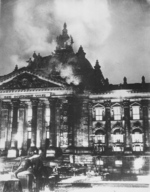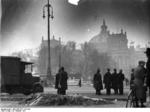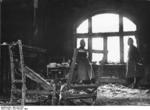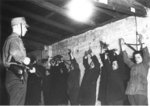The Reichstag Fire
Contributor: C. Peter Chen
ww2dbaseIn an attempt to gain a stronger hold in the German parliament, Chancellor Adolf Hitler convinced President Paul von Hindenburg to dissolve the current parliament and call for a new election, which was to take place on 5 Mar 1933. If the Nazi Party could gain two-thirds majority in the parliament, Hitler would be able to get the Enabling Act passed, which would give him the special power to pass laws without the Parliament.
ww2dbaseAt 2125 hours on 27 Feb 1933, the Berlin Fire Department received a message that the Reichstag building, where the parliament met, was on fire. The fire was put out at 2330 hours, but by then the building had largely been destroyed by the fire. Afterwards, firemen and policemen inspected the ruins and found twenty bundles of unburned inflammable material. Marinus van der Lubbe, a Dutch communist, was arrested as the arsonist. When Hitler arrived on the scene, it was uncertain what he felt. Some claimed that Nazi Party leaders planned the fire to frame the communists, while others thought they had no knowledge of this fire until it happened. Regardless, Hitler immediately seized upon the opportunity to attack the Communist Party in the effort to secure more seats in the parliament for the Nazi Party. He claimed that the Reichstag Fire was the start of a communist revolution, thus creating a special emergency situation where Hindenburg deemed necessary to issued the Reichstag Fire Decree, which suspended key civil liberties in Germany, allowing the Nazi Party to mount propaganda campaigns against the communist party and ban publications that spoke out against the Nazi Party. In the following days, upwards of 10,000 political opponents of the Nazi Party, most of whom communists, were arrested.
ww2dbaseEpilogue
ww2dbaseAt the 5 Mar 1933 election, the Nazi Party increased their hold of the parliament from 33% to 44%. Although not achieving the 66% that he had hoped for, Hitler was able to get the parliament to pass the Enabling Act through persuasion with friendly political parties and intimidation against rival ones on 23 Mar. The Enabling Act went into effect on 27 Mar.
ww2dbaseIn Jul 1933, Marinus van der Lubbe and others were indicted in a German court of law for the fire. The trial took place in Leipzig, Germany between 21 Sep and 23 Dec 1933. During the trial, van der Lubbe insisted that he acted alone in the fire, while communist leaders claimed that the Nazi Party was trying to use van der Lubbe as a weapon to attack the Communist Party. Van der Lubbe alone was found guilty and sentenced to death by beheading (carried out by guillotine in a prison on 10 Jan 1934) while the other defendants were expelled to the Soviet Union. Hitler was furious with the court decision, as it undermined his efforts to convince the German people that the communists were planning to revolt, and the nation should gather behind him to fight against this revolution. With his newly found near-dictatorial powers via the Enabling Act, he decreed that charges of treason from that point forth must be tried by a newly established People's Court (Volksgerichtshof) which, expectedly, had closer ties with the Nazi party than the Supreme Court.
ww2dbaseSource: Wikipedia.
Last Major Update: Mar 2010
The Reichstag Fire Mapa Interativo
Photographs
 |  |  |  |
The Reichstag Fire Timeline
| 27 fev 1933 | The German Reichstag building was destroyed by fire. 10,000 political opponents of the Nazi Party, mostly communists, were subsequently arrested. |
| 28 fev 1933 | German President Paul von Hindenburg issued the Reichstag Fire Decree, suspending key civil liberties in Germany. |
| 23 mar 1933 | German Reichstag passed the Law for Removing the Distress of People and Reich ("Enabling Act"), giving dictatorial powers to Hitler. It was to be in effect on 27 Mar 1933. |
| 27 mar 1933 | The Enabling Act, which gave Hitler near-dictatorial powers, came into effect. |
Você gostou deste artigo ou achou este artigo útil? Se sim, considere nos apoiar no Patreon. Qualquer valor já vai ajudar! Obrigado. Por favor, ajude-nos a divulgar o site: Fique atualizado com WW2DB: |
Visitor Submitted Comments
All visitor submitted comments are opinions of those making the submissions and do not reflect views of WW2DB.

» Germany
- » 1,181 biografias
- » 337 eventos
- » 45,111 entradas na linha do tempo
- » 1,246 navios
- » 350 modelos de aeronaves
- » 207 modelos de veículos
- » 376 modelos de armas
- » 123 documentos históricos
- » 261 instalações
- » 470 eventos
- » 28,473 fotos
- » 365 mapas
Thomas Dodd, late 1945
Por favor, considere nos apoiar no Patreon. Mesmo R$1 por mês já faz uma grande diferença. Obrigado!
Ou, por favor, nos apoie adquirindo alguns produtos do WW2DB na TeeSpring. Obrigado!
1 Jan 2015 11:08:32 AM
who took that picture?